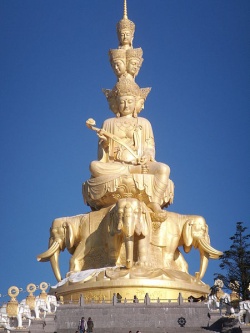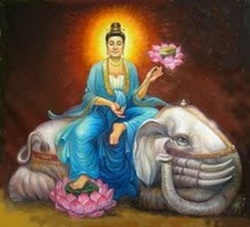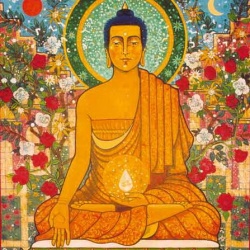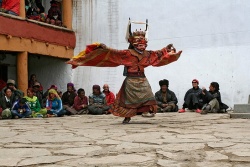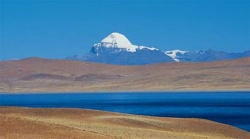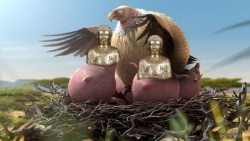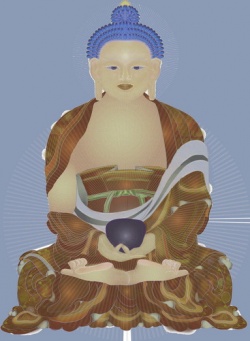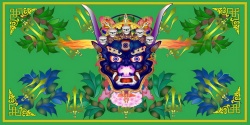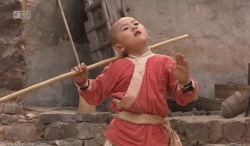Masters of Nyingma lineage
Samantrabhadra
Samantabhadra, the primordial Buddha is pure omniscience, the essence of the enlightened mind of all the Buddhas. Embracing Samantabhadri, the female primordial Buddha, their union represents the fusion of wisdom and compassion, the ultimate indivisibility of samsara and nirvana and the potential for Buddhahood inherent in all sentient beings.
Samanta means, “universally extending.” Bhadra means “great virtue.” Samantabhadra means to extend such great compassion that every sentient being is benefited and to practice so extensively and profoundly that all virtue is perfected.
Samantrabhadra
Vajrasattva
Vajrasattva is the manifestation of the purity of body, speech, and mind of all the Buddhas. As a meditational deity Vajrasattva is visualized as an expression of mind’s pure essence. In this way negativities and obscurations are cleansed allowing Buddha nature to manifest. As a Bodhisattva, Vajrasattva saw that all beings suffered because of their negative karma and made a vow to free all beings of this karma.
Nirmanakaya Buddha Shakyamuni Nirmanakaya Buddha Shakyamuni
In 626 B.C.E. our supreme Dharma teacher, Buddha Shakyamuni, was born southern Nepal, which in ancient times was northern India. At the age of thirty-five, Shakyamuni attained Buddhahood in Bodhgaya, India and began to teach the dharma in this world. For the next forty-seven years the Buddha’s teachings flourished throughout the universe and as a result many sentient being attained enlightenment. At the age of eighty-two, Buddha Shakyamuni passed into nirvana. Thereafter, the Buddha Shakyamuni manifested in two wisdom emanations.
Padmasambhava
The Second Buddha, Guru Padmasambhava established a lineage of oral transmission known as the Kama, which passes from teacher to disciple. The Kama continues unbroken up to the present. Guru Padmasambhava and Wisdom Dakini Yeshe Tsogyal also concealed various types of spiritual treasures known as Terma, which are discovered by revealers of spiritual treasure known as tertons. This is known as the Terma lineage.
Rongzom Choki Zangpo
Rongzom Choki Zangpo who was renowned as the supreme mahapandita of Tibet, the land of snow mountains, took birth in Narlung-rong, a subdistrict of Rulak in lower Tsang. The rite of the five awakenings of the causal phase was first performed by hi father Rongben Rincen Tshultrim, the son of Rongben Pelgi Rinpoche. Consequently, during his lifetime he was to demonstrate an enlightenment exemplifying five excellences; Dignaga’s discriminative awareness, Vasubandhu’s learning, Candragomin’s expressive style, Dharmakirti’s analytical acument, and master Aryasura’s poetic composition.
It is said that Rongzompa was the immediate reincarnation of a pandita called master Smritijnanakirti, who had come to Tibet towards the end of the early propagation of the teaching. In the province of Dokam he corrected the translations of some of the tantras, and translated commentaries on the way of secret mantra.
Longchen Ramjam
Longchen Rabjam (1308 – 1363) was the reincarnation of Princess Pemasal, the daughter of King Trisong Deutsen and a direct student of Guru Rinpoche. His birth in the Tra Valley of Southern Tibet was accompanied by miraculous events and auspicious omens. He began his Dharma training at the age of seven, when he received empowerments and teachings from his father, a tantric yogi. At twelve, he took novice monastic vows at Samye monastery.
Longchenpa studied and practiced teachings from a variety of lineages and masters. He received and mastered so many teachings, in fact, that he became known as Samye Lungmangwa, the One of Samye with Many Transmissions. Though he is associated primarily with the Nyingma lineage, he also studied many teachings of the Sarma, or New Schools, including the Kalachakratantra, Chöd, and the Path and Result teachings of the Sakya lineage. He shared a particularly close relationship with the third Karmapa, Rangjung Dorjé, with whom he studied under the Dzogchen master Rigdzin Kumaraja.
Longchenpa passed away at the age of fifty-six. He left over two hundred and fifty treatises behind, many of which are still regarded as the most comprehensive and authoritative works yet written concerning the view and practice of the Great Perfection. His most important students include the 3rd Karmapa, Rangjung Dorjé, with whom he exchanged teachings, Özer Kocha, and his son, Tülku Trakpa Özer.
Rigdzin Jigme Lingpa
As a child Jigme Lingpa remembered previous incarnations, his mind was detached from wordly concerns and he was extraordinarily compassionate, intelligent and courageous. At age 6 he entered Palri Monastery, but lived the life of a poor novice with nothing to facilitate learning. His intense zeal for the Dharma, devotion to Guru Rinpoche, and rich inner life filled sustained him and he felt no need to have a master or study intellectual subjects in detail as other students were doing. He learned merely by overhearing the classes of other students or glancing at the texts.
In his twenty-eighth year he started a strict retreat concentrating his meditation on the development and perfection stages. He experienced many visions of Guru Rinpoche, Yeshe Tsogyal, Manjushrimitra and others, each further awakening his inner wisdom. One evening with an unbearable devotion to Guru Rinpoche in his heart, he experienced flying through the sky to the circumnambulation path of the Bodhnath stupa. In the courtyard of the stupa a dakini entrusted him with a wooden casket containing yellow scrolls and crystal beads. Encouraged by another dakini he swallowed these and instantly experienced the full awakening in his mind of all the words and meaning of the Longchen Nyingthik cycle.
Three years later during a retreat at the Chimpu caves the highest realisation of Dzogchen awakened in him through three visionary transmissions of the Longchen Nyingthink teachings from Longchen Rabjam. He kept them secret for seven years, until a clairvoyant disciple beseeched Jigme Lingpa to transmit them. Swiftly the teachings reached every corner of the Nyingma world and became the heart core of meditation instructions for many realised meditators to this day.
Rigzin Terdag Lingpa
Rigzin Terdag Lingpa was the speech emanation of the great translator Vairocana. At the request of the dakinis, the body of his pristine cognition assumed the form of Heruka and Terdag Lingpa, accompanied by rainbows and various wondrous omens, was born on Monday, March 26, 1646 (tenth day, second month, fire dog year).
His mother was Yum Lhandzin Yangchen Drolma, who was herself a direct descendent of the Chögyal Dynasty of the great kings Songtsen Gampo and Trisong Deutsen.
His father, Sangdak Thrinley Lhundrup, was the reincarnation of Nubchen Sangyay Yeshe, one of the twenty-five disciples of Guru Padmasambhava. Sangdak Thrinley Lhundrup himself, born at Chak Jangchubling in 1611 (iron female pig year), was the son of Khedrub Don-Nga Tenzin, a learned and accomplished teacher of the Nyö clan. Sangdak Thrinley Lhundrub was a renowned scholar and teacher who studied wwith more than 30 highly accomplished masters of the time. He then bestowed these profound and vast teachings on his supreme spiritual son of body, speech and mind, the great treasure finder Chögyal Terdag Lingpa Rigzin Jurme Dorje.
Lochen Dharmashri
Lochen Dharmashri received the Refuge and Bodhicitta Vows from Terdak Lingpa, who was his principle guru. At the age of twelve, Dharmashri received the empowerment of Rigdzin Thugthig (The Heart Essence of the Vidyadharas) from Terdak Lingpa, due to which his mind matured, and the pratimoksha and bodhicitta vows which he later received arose as the essence of the discipline of secret mantra.
When Dharmashri was fifteen, he received novice monastic vows from the Fifth Dalai Lama, from whom he also received full ordination when he reached the age of twenty. Fulfilling the instruction of the Dalai Lama, he later received the pure lineage of the Lower Tibetan Vinaya of the Nyingma. This was the Vinaya lineage from Kham which had survived the persecution of the buddhadharma by King Langdharma; Dharmashri became a great preserver of this tradition, widely propagating its explanation and practice. He and his elder brother, Terdak Lingpa, both sought out the great doctrine holders of the time, and received an enormous number of transmissions on an equally vast number of topics.
Jigme Galweynege
Jikme Gyalwe Nyugu was a great meditator, bodhisattva and adept. Born in 1765 In the Dzachuka valley, he experienced unbearable urges as a child to go to a solitary place and devote himself to meditation. As a youth he made a pilgrimage to Samye and other holy places and received instructions on Dzogchen, but his family obliged him to join his elder brother on business trips.
During these he was overcome with revulsion for the lying and cursing practiced by laypeople. When his brother died at age 18 this more than any other single event, turned his mind resolutely to Dharma, but relatives put great pressure on him to marry and take care of the family. He was forced to run away from home and traveled to Central Tibet with a like-minded friend. At Samye they met with the first Dodrupchen who advised them to see Jigme Lingpa. When they reached Tsering Jong and beheld Jigme Lingpa, Jigme Gyalwe Nyugu experienced incredible joy. They received empowerments, transmissions and detailed instructions on Dzogchen.
After several more retreats in east Tibet he returned to Tsering Jong and experienced once more the great joy of seeing the omniscient Jigme Lingpa, who invited him to stay for three years. He explained frankly that he had to go back home because of obligations. He returned to Kham and did many years retreat around Dzogchen and in Dzachuka and had many extraordinary experiences. As advised by Jigme Lingpa, he devoted the entire latter part of his life to teaching whoever came to listen, giving empowerments or meditation instructions to all who were devout and sincere. During this period, he gave Patrul Rinpoche teachings on the Ngöndro of Longchen Nyingtik 25 times as well as the teachings on Tsalung and Dzogchen.
Patrul Rinpoche
Patrül Rinpoche (1808-1887) was born in the Dzachuka valley of Eastern Tibet. Although he is generally considered to have been the speech incarnation of the great tertön Jigmé Lingpa, Patrül Rinpoche was originally recognized as an incarnation of Palgé Tülku, a lama from Dzogchen Monastery. The first Dodrupchen Rinpoche, one of Jigmé Lingpa’s two main disciples, entrusted young Patrül with the Longchen Nyingthik lineage shortly after the recognition. He practiced, studied, and taught this lineage throughout his life.
Patrül Rinpoche studied with many different masters. His two main teachers, however, were Jigmé Lingpa’s second main disciple, Jigmé Gyalwé Nyugu, and the great tantric yogi Do Khyentsé Yeshé Dorjé, the mind incarnation of Jigmé Lingpa. Under these and other important lamas, he studied a vast array of topics, from the foundational teachings of the Hinayana up to the most profound and secret oral instructions of the Great Perfection.
At the age of twenty, Patrül Rinpoche left the residence of his predecessor and took up the life of a wandering hermit. For the rest of his days, Patrül wandered from mountain retreats to large monasteries, practicing the teachings, instructing students, and composing commentaries on important texts and practices. Though he was master of the Great Perfection teachings, he had a passion for teaching the Mahayana as well. He taught Shantideva’s Bodhicaryavatara over a hundred times. Throughout his life, Patrül Rinpoche demonstrated the impeccable life of a true siddha/scholar; he kept few possessions, had no fixed abode, and was often mistaken for a beggar due to his humble appearance.
Patrül Rinpoche’s heart disciple was Lungtok Tenpé Nyima, who lived with him for twenty-eight years. His other disciples include some of the 19th century’s most outstanding masters. Among them were Mipham Rinpoche, Khenpo Künpal, the 3rd Dodrupchen Rinpoche, the famed tertön and teacher of the 13th Dalai Lama Lerab Lingpa, and Adzom Drukpa. Patrül Rinpoche died at the age of 80.
Ju Mipham
Ju Mipham (1846-1912) ranks alongside Longchen Rabjam and Tsongkhapa as one of Tibet’s most prolific and influential masters. His presentation of the Nyingma School’s unique approach to the view and practice of Buddhism, and in particular the relationship between Madhyamaka and the Great Perfection, has had an enormous impact on the past few generations of Tibetan Buddhist scholars and practitioners. [[Namdrolling Monastic] College]], currently the largest functioning Nyingma educational institution, includes twenty of his texts in its curriculum. By comparison, only five texts by Longchenpa are included and only one by Rongzom Pandita.
Mipham’s primary teachers were Patrül Rinpoche and Jamyang Khyentsé Wangpo, both incarnations of the tertön Jigmé Lingpa. Khyentsé Rinpoche requested Mipham to preserve the Nyingma teachings through teaching, debate, and composition—a task in which he admirably succeeded. About his remarkable student, Khyentsé remarked: “In this time, there is no one else on earth more learned than lama Mipham.”
He excelled not only in study and teaching, however, but in practice as well. The numerous retreats he completed were always accompanied by miraculous signs of accomplishment.
Mipham Rinpoche’s collected writings comprise twenty-seven volumes and cover a vast array of topics. Among his most influential writings are The Speech of Delight—a commentary on Shantarakshita’s Ornament of the Middle Way, Gateway to Knowledge—which provides an overview of the Buddha’s teachings, and Beacon of Certainty—an elucidation of the view of the Great Perfection and its relationship to the Middle Way teachings.
Botrul Do-ngak Tenpai Nyima
Botrul Do-ngak Tenpai Nyima (1900 – 1959) was born in Dakpo, in the eastern part of central Tibet. When he was very young, his spiritual predisposition awakened and he entered the path of dharma. At a certain point, he joined an eastern Tibetan merchant on a pilgrimage and journeyed to eastern Tibet in search of teachings. Because he was still so young and his homeland was far away, Do-ngak Tenpai Nyima had no provisions for supporting himself while receiving teachings and therefore endured many hardships, including a lack of adequate clothing, and adopted a way of life reminiscent of the lord Milarepa’s.
He finally reached Dzogchen Monastery in eastern Tibet and studied with all of the gurus, tulkus, khenpos, and teachers residing there, investigating the thirteen great source texts and teachings from the sutras, tantras, and other fields of knowledge. He joined the ranks of the learned. From Dzogchen Tupten Chokyi Dorje, he received many empowerments and oral transmissions for the practice of tantra. Dzogchen Rinpoche took responsibility for Botrul Do-ngak Tenpai Nyima and accorded him many honors. For example, he conferred the title of tulku on him, seated him during large gatherings on a throne that stood in the center at the back of the hall, and assigned several monks as his attendants when he traveled. Everyone honored him as Bopa Tulku.
Botrul Do-ngak Tenpai Nyima attracted many students from all directions and upheld and fostered Mipam Rinpoche’s teaching methods. Among his students were Khen Chochap, Perna Tsewang Lhundrup, Khen Tupten of Mepa, Khen Tupten of Rahor, Khen Dazer, and many other learned masters. He wrote numerous extensive and more concise works, including The Delination of the Tenets of View, An Overview of the Perfection of Sublime Knowledge, and A Word-by-Word Commentary on the Perfection of Sublime Knowing.
Khenchen Tupten Chopel
Khenchen Tupten Chopel of Changma was a student of Khenchen Yonten Gyatso. His birthplace was a nomadic community in the Batur region of the Dalung river valley in the northern reaches of someone holy, such as faith, renunciation, a lack of interest in worldly matters, and compassion. At the age of eleven, he entered the monastic community of Puntsok Norling and, beginning with reading and writing, trained in all the usual fields of knowledge. He was ordained as a novice by Khenchen Yonten Gyatso. At twenty-four Tupten Chopel requested additional vows and became a fully ordained monk. Tupten Chopel studied myriad source texts and pith instructions of the Early Translation school, such as the teachings on and the mind teaching. In particular, from Khenchen Yonten Gyatso, the extraordinary master of his buddha family, Tupten Chopel received the earlier and later cycles of the secret Nyingtik teachings of the Dzogchen approach, as well as teachings on the most majestic tantra, and other cycles, receiving these as experiential transmissions based on the oral instructions of the lord of the dharma Paltrul Rinpoche. He put these teachings into practice and experienced the enlightened intent that is the ultimate lineage. Serving thus as a glorious protector of the teachings and of beings, Tupten Chopel lived for seventy-one years. Of his students, the foremost were Khenchen Jigme Puntsok, Kyabje Dilgo Khyentse Rinpoche and Khenche Pedma Tsewang of Arigzha.
Khenchen Pema Tsewang LhundrupKhenchen Pema Tsewang Lhundrup
After taking birth in Dza Chukha in the eastern area of Dokham, Khenchen Pema Tsewang Lhundrup was from early childhood endowed with an extraordinary intelligence and a compassionate character. Many accomplished masters foretold that he was an emanation of Vajrapani, the Lord of Secrets who is the compiler of the teachings of all the victorious ones, and of great beings such as the Tibetan great Lotsawa Dharma Shri.
When eleven years of age, he received the ordination to be a novice. From then on and up to the age of 28, he followed numerous learned and accomplished spiritual masters including Adzom Gyalsey Gyurmey Dorje, Tubga Yishin Norbu, Botrul Tamchey Khyenpa, Jamgon Shechen Kongtrul, Paltrul Namkha Jigmey, Pukung Khenchen Chodor, and many others. From these masters he received the complete training in Sutra, Mantra and the authoritative fields of knowledge, and thereby earned the title “mahapandita of the five-fold fields of knowledge.”
At the age of 28, he received the full monk ordination from Dzogchen Khenchen Tubten Nyendrak and has since then correctly observed the three level of precepts – Pratimoksha, Bodhisattva, and Mantrayana – with neither conflict nor transgression. Due to his peaceful nature and his gift for never getting angry, he has become an example for Buddhists all over the world.
From 29 to 51, he remained in loose retreat during which he chanted the Manjushri Nama Sangirti Tantra in six hundred verses several hundred thousand times. In this way he has earnestly practiced, like the steady flow of a river, the profound and secret levels of meditation and sadhana, and hereby realized the self-existing wakefulness of the Great Perfection in which insight and compassion are indivisible.
From the age of 52, he functioned as the khenpo at Dzogchen Shri Singha, the great Buddhist Institute for Higher Learning. There he taught for four years several hundred students in the ten fields of knowledge. He has traveled widely throughout the world, and it is through his kindness of constantly teaching the sublime Dharma of both Sutra and Tantra, that he has spread an immense benefit that extends to many hundred thousand people.
In short, he is an accomplished great Dharma Master, a confluence of erudition, purity and noble-mindedness. At present, his residence is at the newly built center for teaching and practice for monks and nuns near Arig in eastern Tibet where he lives at a mountain hermitage while teaching the Dharma of Sutra, Mantra and the fields of knowledge.
Khenchen Jigme Phuntsok Rinpoche
H.H. Khenchen Jigme Phuntsok Rinpoche (1937 – 2004) was born in 1937 in eastern Tibet. He was a reincarnation of the great master Terton Lerab Lingpa, and discovered terma treasures in this lifetime as well. Rinpoche was the foremost teacher in residence in modern Tibet. A brilliant scholar and eloquent speaker, he regularly addressed gatherings of monks, nuns and lay people numbering in the thousands. He was the founder of the great university center of Larung Gar that attracted over 15,000 students drawn there by his greatness.
In 1993, Rinpoche was able to visit H.H. the Dalai Lama in India and bestow transmissions to His Holiness. H.H. Khenpo Jigme Puntsok Rinpoche passed away at the age of 72 years on the evening of January 6, 2004, in a military hospital in Chengdu, China. His recent passing is a great loss to Buddhism in Tibet.
Adzom Drukpa Rinpoche
Adzom Drukpa Thubten Pema Trinley (1921-2001) was one of the greatest scholars in Tibetology, as well as an accomplished Dzogchen Master and Mahasiddha of the rainbow body.
Rinpoche was born in the Fire Tiger year (1926) in Kham area, nearby a sacred terma place of Guru Rinpoche, Yulhong Lhari Mountain (today’s Dege District of Sichuan Province).
Rinpoche was recognized by the 5th Dzogchen Rinpoche, Thubten Chokyi Dorje as the unmistaken reincarnation of the previous Adzom Drukpa Dordul Pawo Dorje (the manifestation of one of the 25 disciples of Guru Rinpoche, Matog Rigzin and Rigzin Chenpo and other masters – the guru of the Great Jamyang Khyentse Chokyi Lodro). In the Earth Dragon year of Tibetan Calendar, Drukpa Rinpoche was enthroned as a high ranked master of the Adzom Monastery.
Rinpoche was renowned for his impartial loving kindness and compassion. Without caring much about his own interests and benefits, he always dedicates himself wholeheartedly and selflessly for the benefit of all. He upheld and maintained pure precepts and virtuous conducts, which made him a great and exalted example of living Bodhisattva, who was highly praised and admired by all. Rinpoche was employed as the professor of Tibetan language in the Higher Buddhist Institute of China and other important positions in social and cultural organizations.
